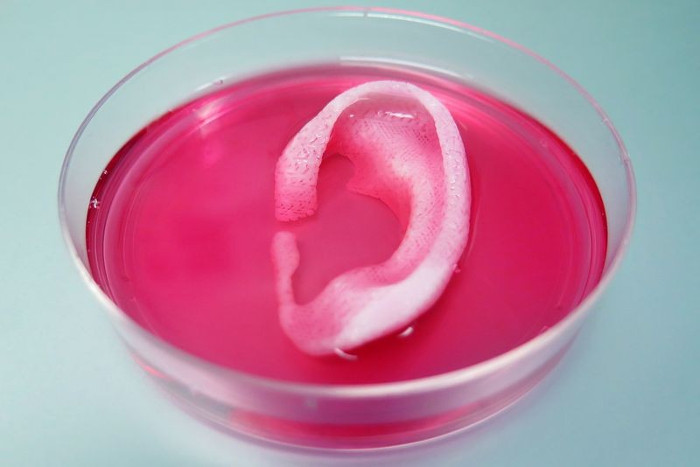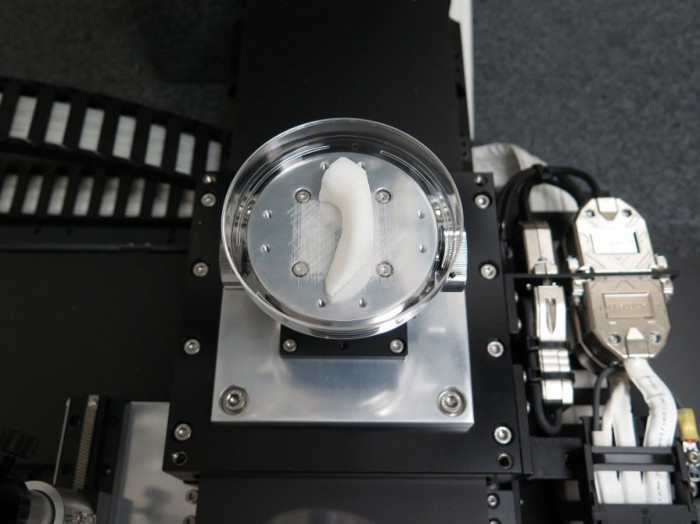Breakthrough technology: Successful 3D printing of human ears with blood vessels and cartilage
Experts have recently succeeded in printing a "alive" ear, marking a turning point in the medical technology industry.
Recently with 3D printing technology, experts have reproduced human ears with both blood vessels and ear cartilage. This is considered a breakthrough, creating the foundation for the "printing" of replacement parts on the human body in the future.

Experts have recreated the human ear with both the blood vessels and the ear cartilage.
This is the success of regenerative medicine scientists at Wake Forest Baptist Medical Center (WFBMC) in Winston-Salem (USA).
Specifically, they used a 3D bioprinter - a machine that can print cells in layers, forming tissues or organs in the body.
However, the drawback of this machine is that the finished product lacks stability, is very "fragile " so it cannot be used for transplanting into the human body.
Moreover, this printer cannot print blood vessels, so the tissue forming will be about 200 micrometers in size - which is too small to work on the human body.

This printer cannot print blood vessels, so the tissue forming will be about 200 micrometers in size.
And now, Dr. Anthony Atala and his colleagues at WFBMC have solved these problems. By adding a form of bio-polymer , the resulting cells are much healthier, enough to withstand until new tissue is formed.
The next problem is making sure the cells live long enough to connect to the body. But with the 10-year built-in organ and tissue integration system (Itop), scientists have successfully built a "bio-ink" that is primarily water to connect cells, at the same time. Print out tiny "paths" inside transporting nutrients and oxygen.

Scientists have implanted a human ear from 3D printing technology into the skin of mice.
Dr Atala said: "This result shows that our biological ink, combined with micro-pathways, has created the right conditions to nourish and support tissue growth."
To prove this, scientists have implanted a human ear from 3D printing technology into the skin of mice. After 2 months, the ear is still intact, while forming cartilage and blood vessels.
Many people consider this a breakthrough of 3D printing technology in particular, and of the medical industry in general. As for experts, they are aiming for a future when human biological tissues will be printed in mass at very affordable prices.
The study is published in Nature Biotechnology.
- China successfully cultivates and implants ears from cartilage cells
- Print human blood vessels with 3D printers
- China successfully implanted 3D blood vessels into monkeys
- Recreate parts of the body with 3D printing technology
- Japan created a breakthrough in cell technology
- It is possible to create skin layers including blood vessels using 3D biological printers
- 3D blood vessels
- Medical breakthrough: culture of blood vessel walls
- Successfully nourish human ears on mice
- New technology creates fake ear like and works like real ears
- 'In' artificial liver from sugar
- Breeding human cartilage in the laboratory
 Green tea cleans teeth better than mouthwash?
Green tea cleans teeth better than mouthwash? Death kiss: This is why you should not let anyone kiss your baby's lips
Death kiss: This is why you should not let anyone kiss your baby's lips What is salmonellosis?
What is salmonellosis? Caution should be exercised when using aloe vera through eating and drinking
Caution should be exercised when using aloe vera through eating and drinking Scientists find traces of modification in DNA: Are humans products of 'design'?
Scientists find traces of modification in DNA: Are humans products of 'design'?  Spaceship Out of Control! What If You Were Forced to Parachute in Space?
Spaceship Out of Control! What If You Were Forced to Parachute in Space?  Breakthrough in human cell mapping project
Breakthrough in human cell mapping project  Struggling with mental health, many turn to AI for therapy
Struggling with mental health, many turn to AI for therapy  AI applications in automatic weapons - a double-edged sword
AI applications in automatic weapons - a double-edged sword  US records case of bird flu not transmitted through animals
US records case of bird flu not transmitted through animals 